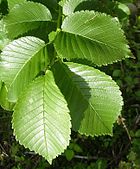- Ulmus 'Clusius'
-
Ulmus hybrid
'Clusius', Netherlands. Photo: Ronnie Nijboer, Bonte Hoek kwekerijen.Details Hybrid parentage ('Exoniensis' × U. wallichiana) × 'Bea Schwarz' selfed Cultivar 'Clusius' Origin Wageningen, The Netherlands A Dutch hybrid elm cultivar raised at Wageningen, 'Clusius' was released for sale in 1983. It was derived from a crossing of the same Dutch clones that produced the fastigiate 'Lobel' released in 1973: 202 (U. glabra 'Exoniensis' × U. wallichiana) and 336 (U. 'Bea Schwarz' selfed).
Contents
Description
The tree has a broader crown than its siblings', whilst the generally obovate leaves, < 11 cm long by 7 cm wide, are less acuminate at the apex [1][2]. Like 'Lobel', the tree flushes markedly later than most other elms, and is rarely in full leaf before mid-May.
Pests and diseases
Whilst the resistance of 'Clusius' to Dutch elm disease proved marginally greater than that of its Dutch predecessors, rated 4 out of 5 [3], it has been eclipsed by later developments such as 'Lutece'. Consequently, sales in the Netherlands declined from over 8,000 in 1979 to 600 in 2004[4] [1].
Cultivation
While it remains for sale in Europe, its planting where the disease remains prevalent cannot be recommended.[5] 'Clusius' featured in New Zealand government trials during the 1990s at the Hortresearch station, Palmerston North, but is not known to have been introduced to North America.
Etymology
The cultivar is named for Carolus Clusius, a Dutch naturalist of the Renaissance.
Accessions
- Europe
- Arboretum de La Petite Loiterie [2], Monthodon, France. No details available
- Grange Farm Arboretum, Sutton St James, Spalding, Lincs., UK. Acc. no. 817.
Nurseries
- Europe
- Barchams [3], Ely, Cambs., UK.
- Bellwood Trees [4], Meigle, Perthshire, Scotland, UK.
- PlantenTuin Esveld [5], Boskoop, Netherlands.
- Standard Trees [6], Golden Cross, East Sussex, UK.
- Tuinenlandschap [7], Doetinchem, The Netherlands
- Westerveld Boomkwekerij B.V. [8], Opheusden, Netherlands.
References
- ^ Heybroek, H. M. (1983). Resistant Elms for Europe. In Burdekin, D. A. (Ed.) Research on Dutch elm disease in Europe. For. Comm. Bull. 60. pp 108 - 113.
- ^ Heybroek, H. M. (1993). The Dutch Elm Breeding Program. In Sticklen & Sherald (Eds.) (1993). Dutch Elm Disease Research, Chapter 3. Springer Verlag, New York, USA
- ^ Heybroek, H. M., Goudzwaard, L, Kaljee, H. (2009). Iep of olm, karakterboom van de Lage Landen (:Elm, a tree with character of the Low Countries). KNNV, Uitgeverij. ISBN 9709050112819
- ^ Hiemstra, J.A. et al. (2007). Belang en toekomst van de iep in Nederland. Praktijkonderzoek Plant & Omgeving, Wageningen UR, Netherlands.
- ^ Burdekin, D. A. & Rushforth, K. D. (Revised by Webber J. F. 1996). Elms resistant to Dutch elm disease. Arboricultural Research Note 2/96. Arboricultural Advisory and Information Service, Alice Holt, Farnham, UK.

This Ulmaceae article is a stub. You can help Wikipedia by expanding it.


